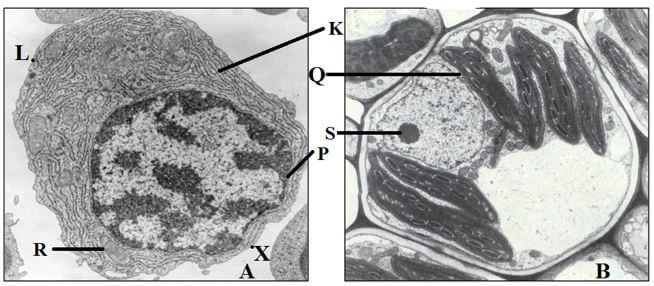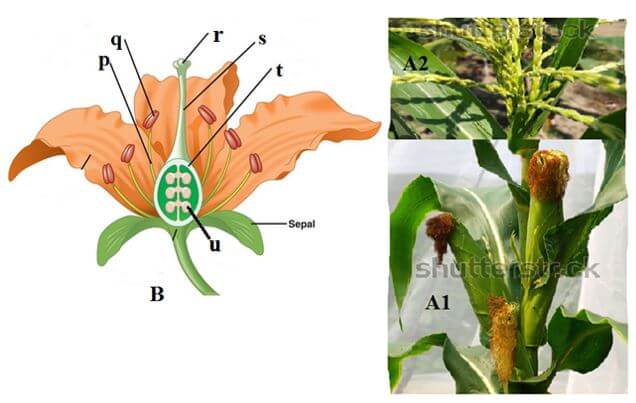INSTRUCTIONS TO CANDIDATES
- Write your name and Index Number in the spaces provided above.
- Sign and write date of examination in the spaces provided above.
- Answer ALL questions in the spaces provided in the question paper.
- You are NOT allowed to start working with the apparatus for the first 15 minutes of the 13/4 Hours allowed for this paper. This time is to enable you to read the question paper and make sure you have all the chemicals and apparatus that you may need.
- All workings MUST be clearly shown where necessary.
- Mathematical tables and silent electronic calculators may be used.
For Examiners use only.
|
Section |
Question |
Maximum Score |
Candidates Score |
|
1
|
14 |
||
|
2
|
12 |
||
|
3 |
14
|
||
|
Total score |
40 |

QUESTIONS
- You are provided with specimen labeled A. Obtain a cube measuring 1cm by 1cm from the specimen.
- Crush the cube using mortar and pestle, place the crushed parts in measuring cylinder, add 2 ml of hydrogen peroxide and quickly determine the volume of foam after 20 seconds and fill the table below. (1 mark)
Explain why the reaction in (a) above occurs in living cells. (2 marks)Specimen
Volume of foam
Crushed cube A
- You are provided with a solution labeled B, unboiled C1 and boiled C2. Place 2ml of the solution B into two test tubes and carry out a food test using the reagents provided. Record your observation in the table below. (2 marks)
Place 2ml of solution B into four test tubes labeled F, G, H and K. Carry out the following steps.FOOD SUBSTANCE
PROCEDURE
OBSERVATION
CONCLUSION
- To test tube labeled F and its contents add 3ml solution C1 and 3 ml distilled water.
- To test tube labeled G and its contents, add 3ml solution C1 and 3 ml dilute hydrochloric acid.
- To test tube labeled H and its contents, add 3 ml solution C 1 and 3 ml sodium hydroxide solution.
- To test tube labeled K and its contents, add 3 ml solution C2.
- Place the test tubes in a water bath at 37 0C for 20 minutes.
- Carry out a Benedict’s test and fill the table below. (4 marks)
- Crush the cube using mortar and pestle, place the crushed parts in measuring cylinder, add 2 ml of hydrogen peroxide and quickly determine the volume of foam after 20 seconds and fill the table below. (1 mark)
|
Test tube |
PROCEDURE |
OBSERVATION |
CONCLUSION |
|
F |
|||
|
G |
|||
|
H |
|||
|
K |
- Account for the observation in:
- Test tube G. (2 marks)
- Test tube H. (1 mark)
- Test tube K. (2 marks)
2. Use the illustration below to answer questions
- Identify the organism from which the cell labelled B was obtained from while giving a reason.
- B. (1 mark).
Reason. (1 mark)
- B. (1 mark).
- Give the functions of the parts labeled:
- R. (1 mark)
- S. (1 mark)
- Name the parts labeled:
- Q. (1 mark)
- P. (1 mark)
- K. (1 mark)
- Calculate the actual length of cell A in micrometers if its magnification Is X1000 000.Use the points marked L and X. (3 marks)
- Explain why cell A and B are believed to have a common ancestry. (2 marks)
3. Use the photographs below to answer questions
- Name the type of flowers shown in A1 and A2.
- A1. (1 mark)
- A2 (1 mark)
- Describe the feature in flowering plants depicted in (a)(i) above. (1 mark)
- Explain how flower labeled A1 is modified for pollination. 1 mark)
- Give the functions of the parts labeled p, r and s in specimen labeled B.
- p. (1 mark)
- r. (1 mark)
- s. (1 mark)
- State the structural descriptions of flower B. (2marks)
- Explain what would happen to the following parts after pollination.
- t. (1 mark)
- u. (1 mark)
- You are provided with a specimen labeled K in a petri dish, observe the specimen using a hand lens and answer questions that follow.
- Make well labeled diagram to show the reproductive structure of the organism. (3 marks)
- Give the type of asexual reproduction exhibited by the organism. (1 mark)

MARKING SCHEME
- You are provided with specimen labeled A. Obtain a cube measuring 1cm by 1cm from the specimen.
- Crush the cube using mortar and pestle, place the crushed parts in measuring cylinder, add 2 ml of hydrogen peroxide and quickly determine the volume of foam after 10 seconds and fill the table below. (1 mark)
Explain why the reaction in (a) above occurs in living cells. (2 marks)Specimen
Volume of foam
Crushed cube A
Not more than 10 ml depending on concentration;1
Cellular respiration produce toxic hydrogen peroxide; enzyme catalase breaks down toxic hydrogen peroxide to harmless products; water and oxygen. - You are provided with a solution labeled B, unboiled C1 and boiled C2 in a boiling tube. Place 2ml of the solution into two test tubes and carry out a food test using the reagents provided. Record your observation in the table below. (2 marks)
Place 2ml of solution B into four test tubes labeled F, G, H and K. Carry out the following steps.FOOD SUBSTANCE
PROCEDURE
OBSERVATION
CONCLUSION
Starch;
To 2ml of food substance in a test tube add 2 drops of iodine solution;
Blue black;
Presence of starch;
(award mark if all steps are correct)
Reducing sugars; 1/2
To 2ml of food substance, add equal amount of Benedict’s solution and boil mixture in water bath.
Turns from blue to green to yellow to orange to brown;
Presence of reducing sugars;
(award mark if all steps are correct)
- To test tube labeled F and its contents add 3ml solution C1 and 3 ml distilled water.
- To test tube labeled G and its contents, add 3ml solution C1 and 3 ml dilute hydrochloric acid.
- To test tube labeled H and its contents, add 3 ml solution C 1 and 3 ml sodium hydroxide solution.
- To test tube labeled K and its contents, add 3 ml solution C2.
- Place the test tubes in a water bath at 37 0C for 20 minutes.
- Carry out a Benedict’s test and fill the table below. (4 marks)
- Crush the cube using mortar and pestle, place the crushed parts in measuring cylinder, add 2 ml of hydrogen peroxide and quickly determine the volume of foam after 10 seconds and fill the table below. (1 mark)
|
Test tube |
PROCEDURE |
OBSERVATION |
CONCLUSION |
|
F |
To 3ml of food substance, add equal amount of Benedict’s solution and boil mixture in water bath |
Turns from blue to green to yellow to orange to brown; 1/2 |
Presence of reducing sugars; 1/2 |
|
G |
To 2ml of food substance, add equal amount of Benedict’s solution and boil mixture in water bath |
Blue colour of Benedicts’s solution is retained. 1/2 |
Absence of reducing sugars; 1/2 |
|
H |
To 2ml of food substance, add equal amount of Benedict’s solution and boil mixture in water bath |
Turns from blue to green to yellow to orange to brown; 1/2 |
Presence of reducing sugars; 1/2 |
|
K |
To 2ml of food substance, add equal amount of Benedict’s solution and boil mixture in water bath |
Blue colour of Benedicts’s solution is retained. 1/2 |
Absence of reducing sugars; 1/2 |
- Account for the observation in:
- Test tube G. (2 marks)
Presence of reducing sugars, Enzyme is denatured by hydrochloric acid;starch not broken down to reducing sugars; - Test tube H. (1 mark)
Presence of reducing sugars, enzyme works best in alkaline condition; starch is broken down to reducing sugars. - Test tube K. (2 marks)
Absence of reducing sugars;enzyme is denatured;starch is not broken down to starch;
- Test tube G. (2 marks)
2. Use the illustration below to answer questions
- Identify the organism from which the cell labelled B was obtained from while giving a reason.
- B. (1 mark)
- Plant;
- Reason. (1 mark)
- Cellulose cell wall;
- Has chloroplast;
- Nucleus at periphery;
- B. (1 mark)
- Give the functions of the parts labeled:
- R. (1 mark)
- Site for respiration that yields energy for the cell;
- S. (1 mark)
- Synthesis of ribosomes;
- R. (1 mark)
- Name the parts labeled:
- Q. (1 mark)
- Chloroplast;
- P. (1 mark)
- Nucleus/cell membrane;
- K. (1 mark)
- Smooth endoplasmic reticulum;
- Q. (1 mark)
- Calculate the actual length of cell A in micrometers if its magnification Is X1000 000.Use the points marked L and X. (3 marks)
- Actual length = drawing length; dawing length=7.6 +1 cm ,=760 mm=760 000 um;
Magnification
760,000 ;
1000,000
=0.76 um;
- Actual length = drawing length; dawing length=7.6 +1 cm ,=760 mm=760 000 um;
- Explain why cell A and B are believed to have a common ancestry. (2 marks)
- Both have a nucleus;
- Both have a nucleolus;
- Both have a mitochondrion;
- Both have endoplasmic reticulum; any 2
3. Use the photographs below to answer questions
- Name the type of flowers shown in A1 and A2.
- A1. (1 mark)
- Staminate;
- A2 (1 mark)
- Pistillate;
- Describe the feature in flowering plants depicted in (a)(i) above. (1 mark)
- Monoecism;
- Explain how flower labeled A1 is modified for pollination. 1 mark)
- Numerous to increase the surface area for attachment of pollen grains;
- Hang outside to trap pollen grains;
- A1. (1 mark)
- Give the functions of the parts labeled p, r and s in specimen labeled B.
- p. (1 mark)
- Hold anthers in position;
- r. (1 mark)
- Receive pollen grains;
- s. (1 mark)
- Support the stigma; allow transfer of male gametes;any 1
- p. (1 mark)
- State the structural descriptions of flower B. (2marks)
- Superior ovary;
- Polypetalous;
- polysepalous;
- brightly coloured petals;
- pedicillate; any 1
- Explain what would happen to the following parts after pollination.
- t. (1 mark)
- Becomes pericarp;
- u. (1 mark)
- Becomes the seed;
- t. (1 mark)
- You are provided with a specimen labeled K in a petri dish, observe the specimen using a hand lens and answer questions that follow.
- Make well labeled diagram to show the reproductive structure of the organism. (3 marks)

- Give the type of asexual reproduction exhibited by the organism. (1 mark)
- Sporulation ;
- Make well labeled diagram to show the reproductive structure of the organism. (3 marks)

CONFIDENTIAL
- Specimen A-potato tissue-half @ student
- Specimen K-bread mould-growth duration-substrate-bread/ugali-5 days
- Hydrogen peroxide- 3 ml@ student
- Distilled water -4ml @ student
- Sodium hydroxide- 4ml @ student
- Dilute hydrochloric acid -4 ml @ student
- 10 ml measuring cylinder -1@ student
- Dropper
- Hand lens-shared
- Knife/scalpel-shared
- Mortar and pestle
- Spatula
- Ruler
- 100 ml beaker
- Source of heat
- Solution B-Starch solution
- Solution C1-UNBOILED amylase-4ml@ student.
- Solution C2-BOILED amylase
- Benedict’s solution.
- 5 test tubes@ student
- 5 labels @student
- Stop watch
- Iodine solution-shared
- Thermometer.
Download Biology Paper 3 Questions, Answers and Confidential - KCSE 2022 Kapsabet Highschool Trial 1 Pre-Mock Examination.
Tap Here to Download for 50/-
Get on WhatsApp for 50/-
Why download?
- ✔ To read offline at any time.
- ✔ To Print at your convenience
- ✔ Share Easily with Friends / Students

